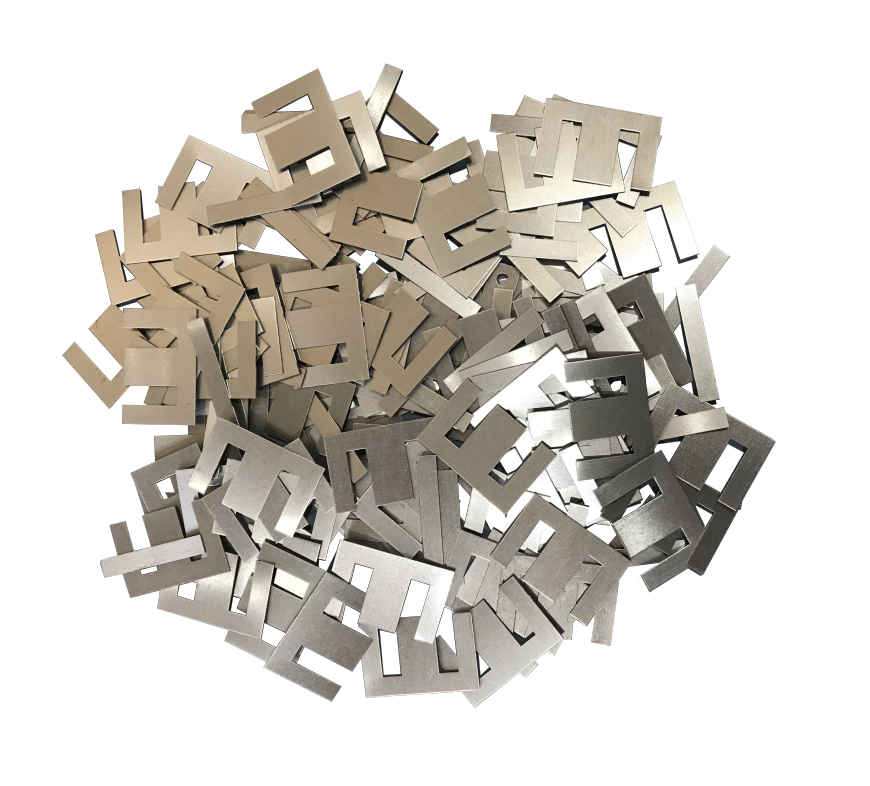Laminated Core materials
The laminated core is a crucial component in various electrical devices and machines due to its unique properties and benefits. This article explores the impact of laminated cores on energy efficiency and overall performance of electric devices. Furthermore, the manufacturing processes, material selection of laminated core are also discussed to find optimum solution to overcome the challenges faced in magnetics design.

Laminated cores are extensively used in the construction of transformers, inductors, motors, and generators. Their laminated structure, consisting of thin layers of magnetic materials, significantly reduces eddy current losses, resulting in enhanced energy efficiency and reduced heat generation.
Eddy currents are induced circulating currents that occur in conductive materials, such as the metal core of transformers and electrical machines, when exposed to changing magnetic fields. These currents lead to energy losses and heating, which can be undesirable in many applications.
Laminated cores are made up of thin sheets or laminations of the magnetic material, such as silicon steel or nickel-iron alloys, stacked together and bonded. The laminations are insulated from each other by a thin layer of oxide or other insulating material. This construction helps to minimize eddy current losses for the following reasons:
Reduced Path for Eddy Currents: The thin laminations decrease the cross-sectional area available for eddy currents to flow. When a magnetic field changes, eddy currents are induced in the core, but the resistance to their flow is increased by the narrow cross-sectional paths provided by the thin laminations. As a result, the eddy currents are constrained to flow only within each individual lamination, reducing their magnitude and overall losses.
Higher Electrical Resistance: The insulating layer between each lamination raises the electrical resistance between them, preventing easy flow of eddy currents across the laminations. This increased resistance further suppresses the eddy current magnitudes and reduces energy losses.
Interlocking Effect: By stacking the laminations together, the interlocking effect can further reduce eddy currents. When the magnetic field changes, the induced eddy currents tend to circulate in loops. The presence of the laminations interrupts these loops, making it more difficult for eddy currents to form continuous paths and thus reducing their strength.
Eddy Current Damping: The presence of the insulating layer between laminations also provides damping for the eddy currents. This means that any eddy currents that are induced will dissipate their energy as heat due to the resistance of the material, further reducing energy losses.
The history of laminated cores dates back to the late 19th century when the first attempts were made to minimize eddy current losses. Since then, widespread adoption of laminated cores in electrical devices has happened due to the unique characteristics and advantages.
There are various manufacturing methods for laminated cores like stamping, welding, and bonding techniques. All these techniques are well known and used widely in industry. The process of manufacturing laminated cores involves several steps:
Stamping: The selected material is cut into precise shapes and sizes using a stamping process. This involves a machine with a die set that cuts out the required shape from the sheet in a repetitive manner. The stamping process ensures uniformity and accuracy of the core shapes.
Insulation: Since the core is made up of stacked laminations, it is essential to prevent electrical currents from flowing between adjacent layers, which would cause energy losses. To achieve this, an insulating coating is applied to each side of the lamination before stacking. Common insulating coatings include varnish or oxide layers.
Stacking: The stamped and insulated laminations are then stacked on top of each other to form the core. The orientation of the laminations is carefully controlled to minimize the formation of continuous magnetic paths, which could lead to eddy currents.
Bonding: Once the laminations are stacked, they need to be held together to maintain the core’s structural integrity. This is usually done through mechanical pressure, interlocking designs, or by applying adhesives that hold the laminations together.
Annealing: The core is then annealed to relieve stresses introduced during the stamping and stacking process. Annealing involves heating the laminations to a specific temperature and then gradually cooling them to enhance their magnetic properties.
Cutting and finishing: After annealing, the core may undergo further precision cutting or grinding to achieve the desired final dimensions and smooth surfaces.
Testing: The finished laminated core is subjected to various quality control tests to ensure it meets the required specifications and has minimal energy losses due to eddy currents.
The resulting laminated core exhibits improved magnetic properties and reduced eddy current losses compared to a solid core made from the same material. This makes laminated cores more efficient for applications in transformers and inductors.
